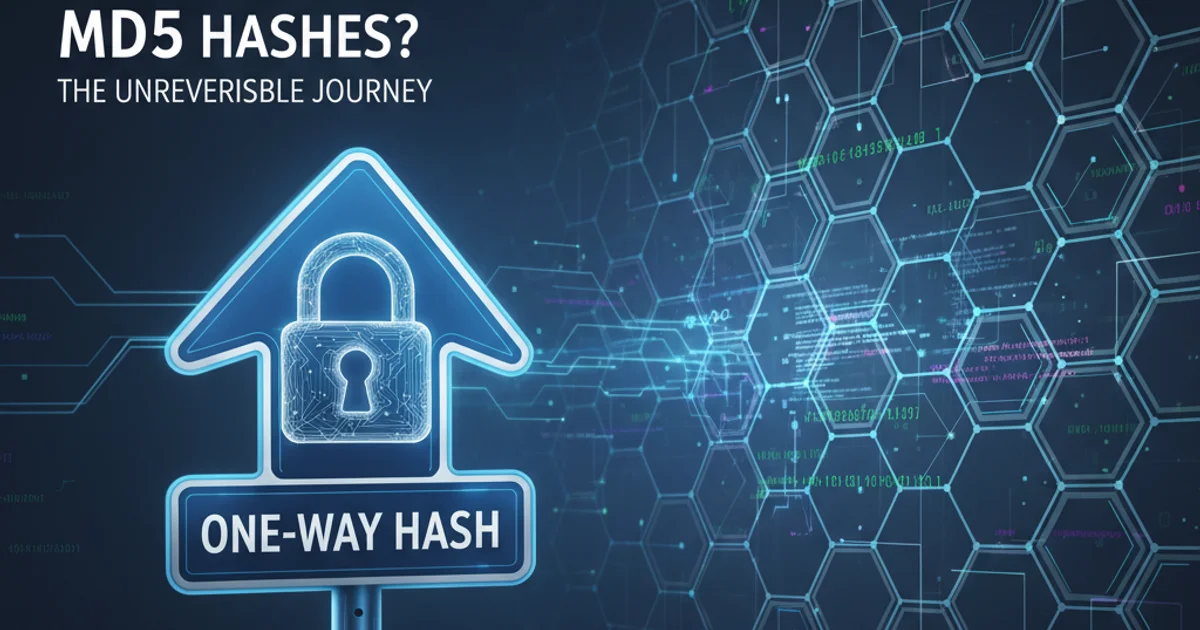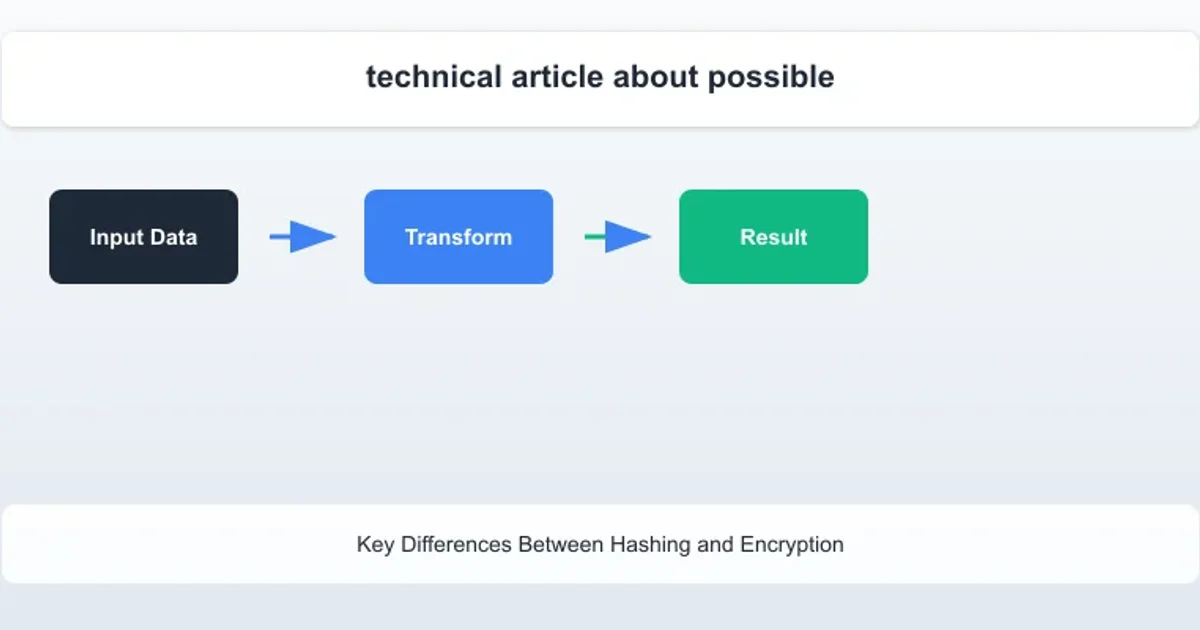Is it possible to decrypt MD5 hashes?
Categories:
The Myth of MD5 Decryption: Understanding Hash Functions

Explore why MD5 hashes cannot be 'decrypted' and delve into the fundamental differences between hashing and encryption, along with the security implications.
A common misconception, especially for those new to cryptography, is the idea of 'decrypting' an MD5 hash. This article aims to clarify why MD5, and indeed all cryptographic hash functions, are fundamentally one-way operations. We'll explore what MD5 is, how it works, and why its design makes decryption impossible, while also discussing its current security status.
What is MD5 and How Does Hashing Work?
MD5 (Message-Digest Algorithm 5) is a widely used cryptographic hash function that produces a 128-bit (16-byte) hash value, typically expressed as a 32-character hexadecimal number. Its primary purpose is to verify data integrity. When you hash a piece of data, the MD5 algorithm processes it to produce a fixed-size output, regardless of the input's size. This output is called a hash, message digest, or fingerprint.
flowchart TD
A[Input Data (e.g., 'hello world')] --> B["MD5 Hash Function"]
B --> C["Fixed-Size Output (Hash Value)"]
C --> D["Cannot be reversed to get Input Data"]
style A fill:#f9f,stroke:#333,stroke-width:2px
style B fill:#bbf,stroke:#333,stroke-width:2px
style C fill:#ccf,stroke:#333,stroke-width:2px
style D fill:#fcc,stroke:#333,stroke-width:2pxSimplified MD5 Hashing Process
The key characteristics of a cryptographic hash function like MD5 are:
- One-Way Function: It's computationally infeasible to reverse the process and derive the original input data from its hash value.
- Deterministic: The same input will always produce the same hash output.
- Collision Resistance (ideally): It should be extremely difficult to find two different inputs that produce the same hash output. (Note: MD5 is no longer considered collision-resistant, as discussed later).
- Avalanche Effect: A small change in the input data should result in a drastically different hash output.
Hashing vs. Encryption: A Critical Distinction
The confusion around 'decrypting' MD5 often stems from conflating hashing with encryption. While both are cryptographic operations, their goals and mechanisms are fundamentally different.

Key Differences Between Hashing and Encryption
Encryption
Encryption is a two-way process. It transforms readable data (plaintext) into an unreadable format (ciphertext) using an algorithm and a key. The primary goal of encryption is confidentiality – to protect data from unauthorized access. With the correct key, the ciphertext can be decrypted back into its original plaintext form. Examples include AES, RSA, and Triple DES.
Hashing
Hashing, as discussed, is a one-way process. It transforms data into a fixed-size string of characters. Its primary goal is data integrity and authentication – to verify that data has not been tampered with or to securely store passwords. There is no 'key' to reverse a hash, and the original data cannot be recovered from the hash value. MD5, SHA-1, SHA-256 are examples of hash functions.
Why MD5 Cannot Be Decrypted
The inability to decrypt an MD5 hash is inherent in its design as a one-way function. Here are the core reasons:
- Information Loss: The hashing process involves irreversible transformations and data compression. For example, a 1GB file will produce a 128-bit MD5 hash. There's simply not enough information in the 128-bit hash to reconstruct the original 1GB of data.
- Collision Potential: Due to the pigeonhole principle, it's mathematically guaranteed that multiple different inputs will produce the same hash output (a 'collision'). If decryption were possible, which original input would it return? This ambiguity makes true decryption impossible.
- No Inverse Function: Unlike encryption algorithms that have a corresponding decryption algorithm, hash functions are designed without an inverse. There's no mathematical operation that can undo the hashing process.
import hashlib
def generate_md5_hash(text):
return hashlib.md5(text.encode()).hexdigest()
original_data = "This is a secret message."
hash_value = generate_md5_hash(original_data)
print(f"Original Data: {original_data}")
print(f"MD5 Hash: {hash_value}")
# Attempting to 'decrypt' this hash is not possible.
# There is no hashlib.md5.decrypt(hash_value) function.
# Example of collision (though finding them is hard for strong hashes)
# MD5 is known to have collisions, making it insecure for some uses.
# For demonstration, let's show a slight change in input
original_data_2 = "This is a secret message!"
hash_value_2 = generate_md5_hash(original_data_2)
print(f"\nSlightly altered data: {original_data_2}")
print(f"MD5 Hash for altered data: {hash_value_2}")
# Notice how different the hashes are for a tiny change (avalanche effect)
Generating an MD5 hash in Python (no decryption function exists)
What About 'MD5 Decryptors' and Rainbow Tables?
You might encounter websites or tools claiming to 'decrypt' MD5 hashes. These tools don't actually decrypt anything. Instead, they use methods like:
- Rainbow Tables: These are precomputed tables of hash values for a vast number of possible inputs. The tool looks up your hash in the table and, if found, returns the corresponding original input. This is effective for common or short passwords but fails for complex or unique inputs.
- Brute-Force Attacks: The tool tries every possible combination of characters until it finds an input that produces the target hash. This is computationally intensive and only feasible for very short or simple inputs.
- Dictionary Attacks: Similar to brute-force, but it uses a list of common words, phrases, or leaked passwords to generate hashes and compare them.
The Security Status of MD5
It's crucial to understand that while MD5 cannot be decrypted, it is no longer considered cryptographically secure for many applications. Significant weaknesses have been discovered, particularly its susceptibility to collision attacks. This means it's possible to find two different pieces of data that produce the exact same MD5 hash. This vulnerability makes MD5 unsuitable for:
- Digital Signatures: An attacker could create a malicious document with the same MD5 hash as a legitimate one.
- SSL Certificates: MD5 has been exploited to forge SSL certificates.
- Password Storage (without salting): While MD5 is still used for password hashing, it should never be used without a strong salt and preferably with a slower, more robust algorithm like bcrypt or scrypt, to mitigate rainbow table and brute-force attacks.
For new applications requiring data integrity or secure password storage, stronger hash functions like SHA-256 or SHA-3 are recommended.